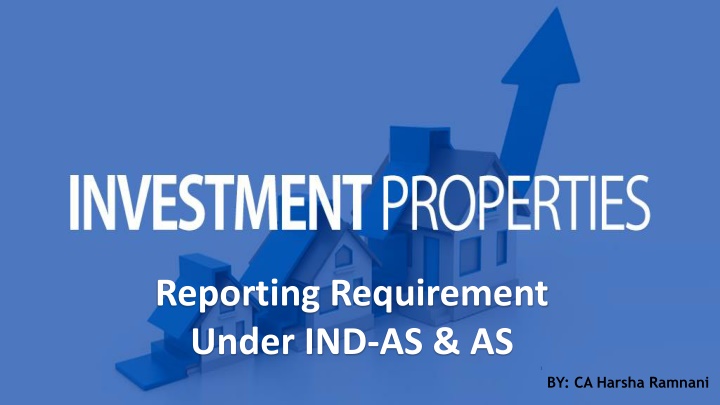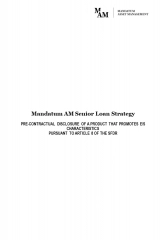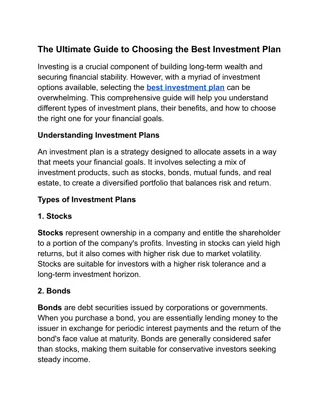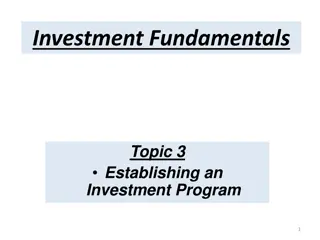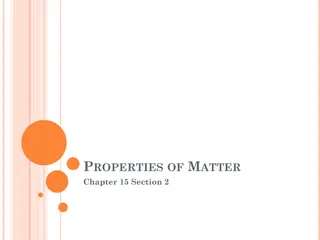INVESTMENT PROPERTIES
Explore key definitions, measurements, and disclosures related to Investment Property under Ind-AS and AS-1, with examples distinguishing between investment property and non-investment property. Learn about dual-purpose properties and how to differentiate them for accounting purposes.
Download Presentation

Please find below an Image/Link to download the presentation.
The content on the website is provided AS IS for your information and personal use only. It may not be sold, licensed, or shared on other websites without obtaining consent from the author.If you encounter any issues during the download, it is possible that the publisher has removed the file from their server.
You are allowed to download the files provided on this website for personal or commercial use, subject to the condition that they are used lawfully. All files are the property of their respective owners.
The content on the website is provided AS IS for your information and personal use only. It may not be sold, licensed, or shared on other websites without obtaining consent from the author.
E N D
Presentation Transcript
Reporting Requirement Under IND-AS & AS 1 BY: CA Harsha Ramnani
Disclaimer The Material/presentation is prepared for the use in educational programmes conducted by the Institute of Chartered Accountants of India. The views expressed herein do not necessarily represent the views of the council of the Institute or any of its Committees.
Agenda Key Definitions of Investment Property (Ind AS) Initial Measurement Subsequent Measurement Disclosures (Ind AS) Key Definitions under AS-13 Reporting Disclosures
Ind-AS 40 Investment Property Investment property (IP): Property (land or buildings - or part of a building) held (by the owner or by the lessee under a finance lease) to earn rentals or for capital appreciation or both rather than for: Use in the production or supply of goods or services or for administrative purposes; or Sale in the ordinary course of business Not Applicable to: Biological assets Mineral rights and mineral reserves such as oil, natural gas and similar non regenerative resources 4
Examples Land held for long-term capital appreciation Land held for undetermined future use Building leased under one or more operating leases Vacant building held to be leased Building under construction or development as investment property 5
Not Investment Property- Examples Sale in ordinary course of business Inventories (Ind AS-2) Owner occupied/ employee occupied property Property, plant & equipment (Ind AS 16) Revenue from customers (Ind AS 115) Constructed for third party Non-current Assets held for sale As per Ind AS 105
Dual Purpose Some properties comprise a portion that is held to earn rentals or for capital appreciation and another portion that is held for use in the production or supply of goods or services or for administrative purposes. If these portions could be sold separately (or leased out separately under a finance lease), an entity accounts for the portions separately. If the portions could not be sold separately, the property is investment property only if an insignificant portion is held for use in the production or supply of goods or services or for administrative purposes. If an entity provides ancillary services to the occupants - such a property is investment property if the services are insignificant to the arrangement as a whole.
Illustration: ABC Limited is a supplier of industrial products. In 2019, the ABC Limited purchased a plot of land on the outskirts of a major city. The area has mainly low-cost public housing and very limited public transport facilities. The government has plans to develop the area as an industrial park in 5 year s time and the land is expected to greatly appreciate in value if the government proceeds with the plan. ABC s management has not decided what to do with the property. How should the management classify such property that is held for undetermined future use?
Solution Management should classify the property as an investment property. Although management has not determined a use for the property after the park s development takes place, in the medium- term the land is held for capital appreciation. Ind AS considers land as held for capital appreciation, if an entity has not determined that it will use the land either as owner-occupied property or for short term sale in the ordinary course of business.
Recognition & Initial Measurement Investment property shall be recognised as an asset only when: It is probable that the future economic benefits associated with the investment property will flow to the entity; and The cost or fair value can be measured reliably Measure initially at cost including transaction costs and directly attributable expenditures (rules similar to Ind-AS 16) 10
Initial Measurement Initially measured at cost Cost Elements Exclusions Directly attributable Purchase Costs costs Start up costs Operating losses incurred before the investment property achieves the planned level of occupancy Abnormal wastage incurred in developing Purchase Price Import duties/non refundable taxes; Deduct trade discounts/rebates. Cost of Employee benefits Cost of site preparation Initial delivery and handling costs Transport handling charges Installation and assembly costs Cost of testing Professional fees
Subsequent Measurement Cost model But fair value must be disclosed After initial recognition, an entity shall measure all of its investment properties in accordance with Ind AS 16 s requirements for cost model, other than those that meet the criteria to be classified as held for sale (or are included in a disposal group that is classified as held for sale) in accordance with Ind AS 105, Non-current Assets Held for Sale and Discontinued Operations. Investment properties that meet the criteria to be classified as held for sale (or are included in a disposal group that is classified as held for sale) shall be measured in accordance with Ind AS 105. Rebuttable presumption: Fair value can be determined reliably on a continuing basis Valuation by a certified independent valuer with relevant experience is encouraged but not required 12
Investment Property - Fair Value Price at which the property could be exchanged in an arms- length transaction FV is time specific, dependent upon market conditions at the reporting date Best measure of fair value is the current price in an active market for similar property (same location & condition) 13
Measurement of Fair Value as per IND AS-113 Fair Value Hierarchy Level 1 Level 3 Level 2 Quoted price of shares traded on stock exchange Quoted price of similar/identical in active/inactive markets Financial Forecasts Historical Volatility
Disclosures (Notes to A/Cs) Accounting Policy used for measuring Investment property: Balance Sheet: Cost Model: Depreciation methods, useful lives, reconciliation of gross carrying amount at beginning and end of the period. Notes: Fair Value Model Criteria to distinguish between investment property and owner-occupied property and inventory Extent to which independent valuer involved and any adjustments to the valuation obtained Rental Income for the year Operating expenses (Repairs or day to day servicing)
AS-13 Accounting of Investment On, 30 March 2016 the Ministry of Corporate Affairs (MCA) issued the Companies (Accounting Standards) Amendment Rules, 2016 to upgrade Accounting Standards (ASs), as notified under Companies (Accounting Standards) Rules, 2006, in order to align them with Ind AS. Changes in Accounting Standard 13- Accounting of Investment Para 3.1 Investments are assets held by an enterprise for earning income by way of dividends, interest, and rentals, for capital appreciation, or for other benefits to the investing enterprise. Assets held as stock-in-trade are not investments . Para 3.4 of AS-13: An investment property is an investment in land or buildings that are not intended to be occupied substantially for use by, or in the operations of, the investing enterprise.
Investment Property Classification: Para 30: An enterprise holding investment properties should account for them as long-term investments. Carrying Value: Para 32: Investments classified as long-term investments should be carried in the financial statements at cost. However, provision for diminution shall be made to recognise a decline, other than temporary, in the value of the investments, such reduction being determined and made for each investment individually
Disclosure under AS-13 The accounting policies for the determination of carrying amount of investments The amounts included in profit and loss statement for: Interest, dividends (showing separately dividends from subsidiary companies), and rentals on investments showing separately such income from long term and current investments. Gross income should be stated, the amount of income tax deducted at source being included under Advance Taxes Paid; Profits and losses on disposal of long-term investments and changes in the carrying amount of such investments; Other disclosures as specifically required by the relevant statute governing the enterprise.
Difference between AS 13 and IND AS 40 Particulars AS 13 Ind AS 40 Guidance on Investment property AS 13 provides limited guidance over investment property Ind AS 40 provides a complete and separate guidance in this regard Inclusion of leased property AS 13 is silent with respect to property held by the lessee under a finance lease Ind AS 40 covers property that is held by the lessee under a finance lease Fair Value Disclosure AS 13 is Silent with respect to fair value disclosure Fair Value disclosure in notes to accounts as per Ind-AS-113
Example for Accounting Policies and Presentation of Investment Property: Drafting of Accounting Policy: Investment Properties: Investment Property is property held either to earn rental income or capital appreciation or for both, but not for sale in the ordinary course of business, use in production or supply of goods or services or for administration purposes. Recognition and measurement: Investment properties are measured initially at cost, including transaction costs. Subsequent to initial recognition, investment properties are stated at cost less accumulated depreciation and accumulated impairment loss, if any. Depreciation: Depreciation is provided over the estimated useful life of the investment property lives which may be different from the useful life prescribed in Schedule II to the Companies Act, 2013. De-recognition: Investment properties are derecognized either when they have been disposed of or when they are permanently withdrawn from use and no future economic benefit is expected from their disposal. The difference between the net disposal proceeds and the carrying amount of the asset is recognised in the statement of profit and loss in the period of derecognition. Though, the Company measures investment property using cost-based measurement, the fair value of investment property is disclosed in the notes. Fair values are determined by independent valuer who holds a recognised and relevant professional qualification and has recent experience in the location and category of investment being valued.
Disclosures in Notes to Accounts: Measurement of Fair Value: The fair value of the investment property has been determined by external, independent property valuer, having appropriate qualifications and recent experience in the valuation of properties in the relevant locations and category of the properties being valued. The fair value has been determined based upon the market comparable approach that reflects recent transaction prices for similar properties. The fair value measurement is categorised in Level 3 fair value based on the inputs to the valuation technique used. The Company has no restrictions on the realisability of its investment properties and no contractual obligations to purchase, construct or develop investment properties or for repairs, maintenance and enhancements. The investment properties consist of commercial properties in India. The Management has determined the investment properties as commercial properties based on the nature of their usage. There has been no change to the valuation technique during the year.
THANK YOU Queries Invited Harsha Ramnani Harsha.ramnani01@gmail.com +91 9001561467
